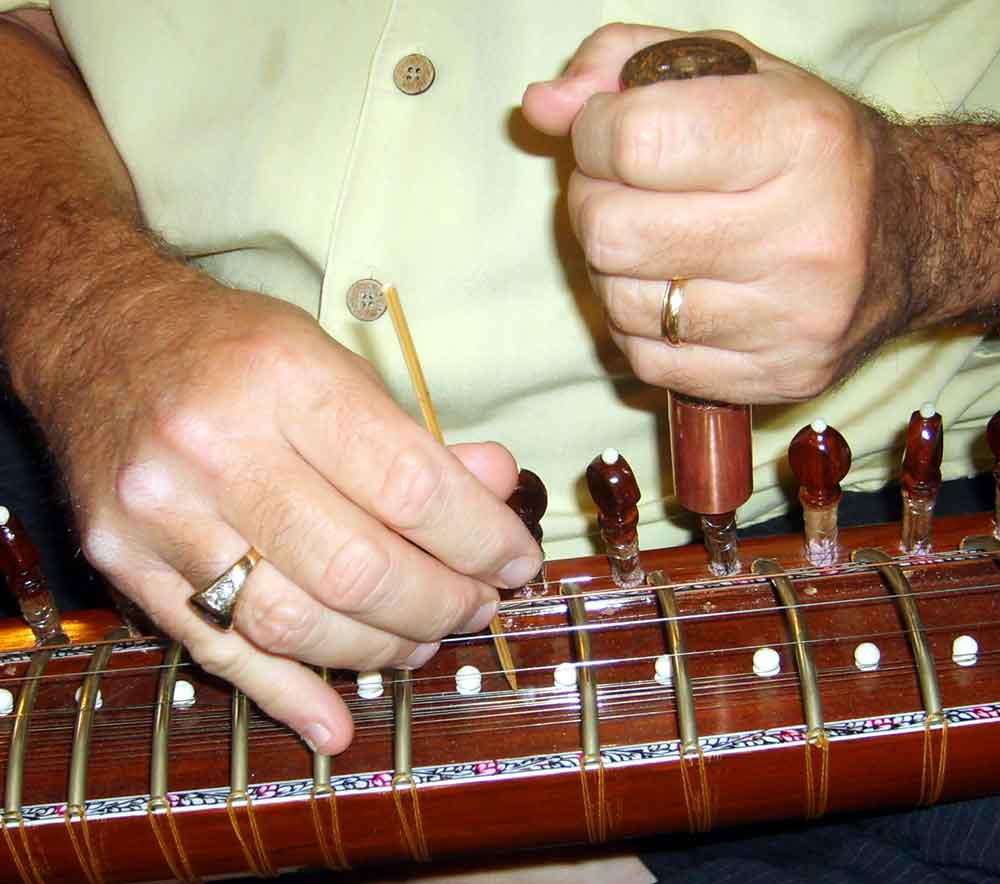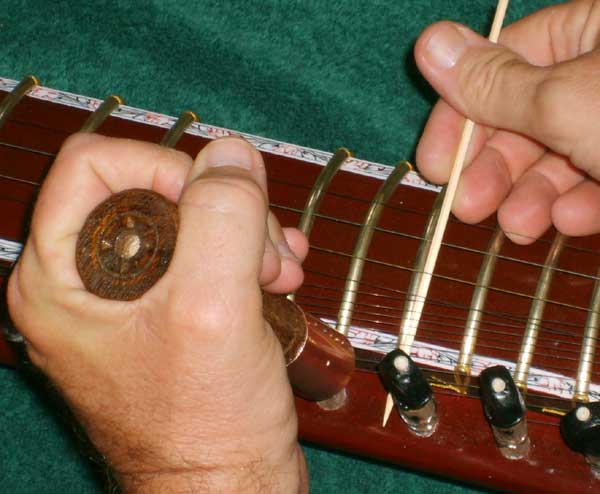Tuning and Stringing the Dilruba or Esraj

| STRINGING AND TUNING THE DILRUBA AND ESRAJ Section 1 – Introduction Section 2 – Basic Concepts of Tuning Section 3 – Overview of Strings Section 4 – Dilruba/Esraj Strings Section 5 – Tools Section 6 – Stringing the Base Section 7 – Stringing the Tuning Pegs Section 8 – Tightening the Strings |
When one is tightening the strings there are a few things to keep in mind. Here we discuss which way to turn the pegs as well as the topic of the settling in of the strings.
Counter Clockwise or Clockwise?
One should be attentive as to whether a string is tightened by a clockwise or a counter-clockwise turn of the key. There are plenty of people who will tell you that one way is better than another. I have tried all ways, and it seems to me that a counter clockwise turn of the pegs is best for tightening the sympathetic strings. I do not believe that it makes much of a difference for the mechanical tuners.
I have seen a number of cases where the default tuning of the mechanical keys is opposite the tuning for the sympathetic strings. If one looks very closely at the mechanisms used, there is a certain logic behind this. However, I feel that having some keys turn clockwise and others turn counter-clockwise is just too awkward. This is especially the case when you have several dilrubas and esrajs. When you are on stage, you already have so many things to concern yourself with that you really do not need the added considerations of which keys, on which instruments, turn in which directions. I have standardised all of my instruments to tighten with a counter-clockwise turn of the pegs. This works for me but you are certainly free to pursue any approach that you like.
| THESE BOOKS MAY NOT BE FOR YOU |
|---|
A superficial exposure to music is acceptable to most people; but there is an elite for whom this is not enough. If you have attained certain social and intellectual level, Elementary North Indian Vocal (Vol 1-2) may be for you. This has compositions, theory, history, and other topics. All exercises and compositions have audio material which may be streamed over the internet for free. It is available in a variety of formats to accommodate every budget. Are you really ready to step up to the next level? Check your local Amazon. |
Settling In
Whenever you replace a string, any string, for any reason, it takes a certain amount of time for the string to settle in. You can minimise this time by pulling the string sharply up as you tune it for the first time. Admittedly this does put strain on the string and carries some risk of breaking. But the time saved in reducing the settling-in time, more than compensates for this risk.
Positioning the Sympathetic Strings (Esraj)
It is important that the sympathetic strings be correctly positioned for the esraj. This is one consideration that esraj players have to contend with that dilruba players do not. As the sympathetic strings wind around the friction peg, there is a correct position that one must be attentive to. If a string wraps around the friction peg too high, it will hit against the number 4 (drone) string. Conversely, if it winds around too low, then it will hit against one of the frets. Neither situation is acceptable, because the sympathetic strings must traverse a fairly narrow space between the frets and the playing strings.
There is a trick that works very nicely; it will allow you to position the sympathetic stings in whatever position you want and do it quite neatly. For this trick, all you need to do is to hold the small wooden pick in whatever angle you wish the strings to go to, then roughly tighten the pegs. You can move the pick alternately to the top side, as well as the bottom side. This will allow you to ease the strings into both their correct pitch, as well as their correct position.
Winding the Sympathetic Strings (Esraj)
Winding the Sympathetic Strings (Esraj) – The esraj has another issue to deal with when tightening the strings; that is the exact manner in which the strings wrap around the friction peg. We must not forget that the sympathetic strings of the esraj do not have an upper bridge; for all practical purposes, it is the friction pegs which are the upper bridge. It only stands to reason that the conditions of the strings as they wrap around the friction pegs will have a major impact upon the sound that the sympathetic stings provide.
The bottom line is simple. Do not let the sympathetic strings wind around the friction peg in some random fashion, or your sound from these stings will be unpredictable. We must make sure that the sympathetic strings are unimpeded by any other string at the point where it comes off of the peg. A good approach is to first wind the strings around the peg in a normal fashion, but just before the string begins to traverse the span to the lower bridge, at that point, pull the winding away form the other loops. If you can keep the string away from the winding at that point, you increase the chances of obtaining a good clear sound.

Conclusion
we looked at the tools and techniques used for tuning an esraj or a dilruba. When these points have been considered against related topics of the strings as well as the approach to tuning, then we have a fairly complete grasp of the subject.
| STRINGING AND TUNING THE DILRUBA AND ESRAJ Section 1 – Introduction Section 2 – Basic Concepts of Tuning Section 3 – Overview of Strings Section 4 – Dilruba/Esraj Strings Section 5 – Tools Section 6 – Stringing the Base Section 7 – Stringing the Tuning Pegs Section 8 – Tightening the Strings |